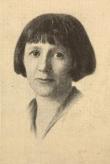Margaret Fane's father came from a well-to-do family of English and Spanish descent. He was born in what was then Ceylon and arrived in Australia as a child. He 'dabbled' in writing and encouraged Fane's interest in literature, particularly in writers such as Dickens and Shakespeare, who were his favourites. Fane's mother was a singer and once appeared with Dame Nellie Melba when Melba was still Nellie Mitchell. Fane herself studied dancing with the intention of going on the stage.
Although she was born in Victoria, Fane spent most of her life in Sydney. In her interview with Zora Cross she relates how she laughed at a cat when she was three months old and continued to see the funny side of things for the rest of her life, an element which is evident in much of her writing. She was educated privately and claimed she received an extensive education because she enjoyed studying.
Fane wrote under several pseudonyms and never used her birth name. It is possible that not all her pseudonyms have been identified. Her interest in writing appeared at an early age, but her spelling was poor and her father stopped her from writing. She wrote some poetry, for which she refused an offer of publication from Triad because she was 'too sensitive', and undertook some work as a literary critic for Aussie, but did not really begin to write until about 1917, when she published poetry in The Bulletin and Lone Hand.
Fane attributed her relative ease in achieving publication to her starting fairly late when she had friends who were able to guide her. For a while she was responsible for the column 'Letters from Margaret' in the PFA Quarterly Journal (later NZL Quarterly), turning to writing fiction seriously when she had stories accepted by The Sydney Mail. The stories comprising her collection The Happy Vagabond were originally published in The Sydney Mail and she was also published in The Australian Journal, The Bulletin and The Australian Woman's Mirror.
Fane believed dialogue was vital to good fiction and saw her pleasure in listening to conversations as an asset to her writing. However, she described herself as being lazy about the 'manual work of writing', which led, in part, to her collaboration with Hilary Lofting. Fane would work out the plot, characters and dialogue in detail and then describe this to Lofting, who would write them down. Lofting's strength was atmosphere and, because he was widely travelled, Fane could set her stories wherever she wished. The amount of input from each varied; she did most of the writing for stories Lofting found 'too Australian', while she left stories set in South America largely to him. All the stories published in The Australian Woman's Mirror were created by Fane, but written up by Lofting.
From 1912 to 1918 Fane lived with the writer and poet David McKee Wright and bore him four sons, but left him for Hilary Lofting. Wright lived with Zora Cross from 1918, but continued to provide for his sons until his death in 1928.

 3581547512331362722.jpg
3581547512331362722.jpg